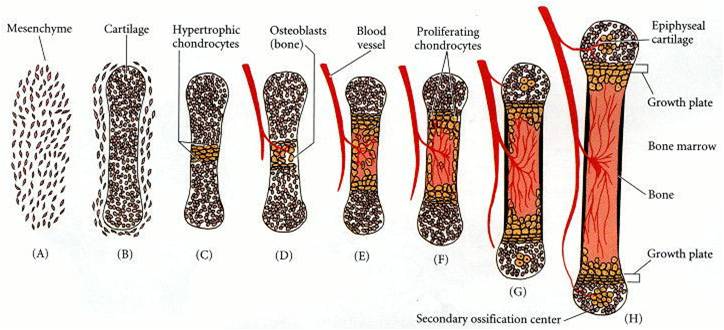Bone Growth and Development Overview
When babies are born, their skeletal system contains 300 components. These components are actually pieces of cartilage, which undergo a process called ossification, that allows them to become bone. The bony skeletal structure begins to develop at 8 weeks, endochondral ossification begins at the second month, and bone growth continues even after birth.
Bony skeleton development:
The pieces that do ossify often fuse together, creating a skeletal system of 206 bones by the end of development. Bones can be classified into two categories: axial skeleton and appendicular skeleton. The axial skeleton contains the bones of the skull, vertebral column, and rib cage. The appendicular skeleton contains the bones of the upper and lower limbs, as well as the shoulders and hips. Bones can also be classified as long bones, short bones, flat bones, and irregular bones. Long bone growth generally stops around the end of puberty, which prevents you from getting taller.
Fetal skull before fusion:
Skull after fusion:
The Ossification Process
There are two types of ossification: intramembranous ossification, which replaces the thin connective tissue membrane with bone, and endochondral ossification, which replaces fetal cartilage with bone. Both types, however, rely on the thyroid hormone calcitonin for the regulation of calcium metabolism.
In bone production, there are three really important cells to consider: osteoblasts, osteoclasts, and osteocytes. Since your bones are always either growing or adapting to support your body, there are cells that will actually destroy bone, and others that will repair the bone to support its new requirements. Osteoclasts originate in bone marrow, and move to the bone surface where they will eat away old bone or protuberances that are out of place. Osteoblasts also come from the marrow and make their way to the surface to fill in cavities and restore bone. After their job is done, they flatten and line the surface of the bone. They then work to regulate calcium, as well as activate osteoclasts through the production of special proteins. Osteocytes come from osteoblasts and can be found inside the bone. As the osteoblasts build the bone, some surround themselves with new material while extending "arms", called dendrites, to other osteocytes. Osteocytes sense pressures and cracks, and help direct osteoclasts to where the bone needs to be dissolved.
The process of ossification:
Diagram of osteoclasts, osteoblasts, and osteocytes in action:
Diagram depicting bone growth and remodeling:
And there you have it: the background of bone growth, development, and remodeling!





No comments:
Post a Comment